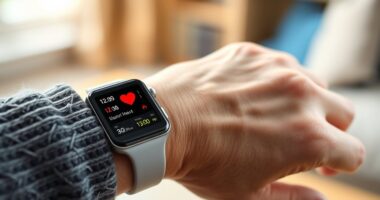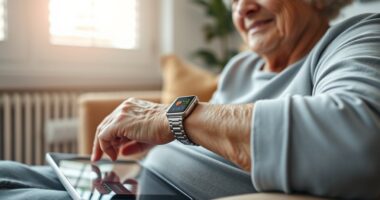Telehealth for home care works by using technology to monitor your crucial signs, medication adherence, and overall health in real-time. It allows you to connect easily with healthcare providers through virtual visits or messaging, enabling personalized and proactive care. Your health data is automatically sent to your care team, so they can address issues early and adjust treatments promptly. If you want to understand how this technology can improve your health, keep exploring the details.
Key Takeaways
- Remote monitoring devices collect vital signs, medication adherence, and health data in real-time for continuous oversight.
- Data is transmitted automatically to healthcare providers, enabling prompt interventions and reducing hospital visits.
- Patients access their health information via user-friendly apps, fostering engagement and active participation in care plans.
- Telehealth enables virtual consultations, messaging, and support, improving communication and timely access to care.
- Incorporating air quality solutions like HEPA filters enhances overall health by improving indoor environments for better recovery.

Have you ever wondered how technology is transforming home healthcare? Telehealth has become a game-changer, making it easier for you to receive quality care without leaving your home. One of the key innovations driving this shift is remote monitoring, which allows healthcare providers to track your vital signs, medication adherence, and overall health status in real-time. This technology gives your care team continuous insights into your condition, so they can intervene early if issues arise. Instead of waiting for the next appointment, your health data is transmitted automatically, reducing the need for frequent hospital visits and providing peace of mind.
Remote monitoring provides real-time health insights, reducing hospital visits and offering peace of mind.
Remote monitoring also boosts patient engagement, a essential element in managing your health effectively. When you have access to your health data through user-friendly apps or platforms, you’re more likely to stay involved in your care plan. You can see how your lifestyle choices impact your health, track your progress, and communicate more actively with your healthcare team. This increased engagement fosters a sense of control and accountability, which can lead to better health outcomes. Many telehealth systems even prompt you with reminders for medication, appointments, or lifestyle adjustments, making it easier to stay on top of your health.
The combination of remote monitoring and patient engagement creates a more personalized approach to healthcare. Instead of generic advice or periodic check-ins, your care team can tailor treatments based on real-time data, addressing issues promptly. This proactive approach not only improves your health but also helps prevent complications that could lead to hospitalization. Plus, it reduces the burden on traditional healthcare facilities, easing congestion and allowing providers to focus on patients who need urgent attention.
Telehealth platforms also facilitate more frequent and flexible communication. Through virtual visits or messaging, you can reach your healthcare provider whenever you need, without waiting days or weeks for an appointment. This immediacy helps you feel more connected and supported, especially if you’re managing chronic conditions or recovering from illness. As a result, you’re empowered to take a more active role in your care while enjoying the convenience of technology that adapts to your schedule. Additionally, integrating HEPA filtration technology into home health solutions can further improve indoor air quality, supporting overall health and recovery efforts.
Frequently Asked Questions
What Devices Are Needed for Telehealth at Home?
You’ll need wearable sensors and a smartphone or tablet with mobile apps to set up telehealth at home. Wearable sensors monitor your vital signs and health data, which are sent securely through the apps. These devices connect via Wi-Fi or Bluetooth, allowing your healthcare provider to track your condition remotely. Make certain your device has a stable internet connection to guarantee smooth communication and accurate health monitoring.
How Is Patient Privacy Protected During Telehealth Sessions?
During telehealth sessions, your privacy is protected through data encryption, which secures your information from unauthorized access. Healthcare providers follow strict privacy policies that dictate how your data is handled, stored, and shared. You’re encouraged to use secure Wi-Fi networks and private spaces, ensuring your conversations stay confidential. These measures help maintain your trust and keep your health information safe throughout your telehealth experience.
Can Telehealth Replace In-Person Home Visits Entirely?
Imagine replacing in-person visits with virtual diagnosis and remote monitoring—sounds like a sci-fi fantasy, right? While telehealth makes healthcare more accessible, it can’t fully replace home visits. You miss out on hands-on care, personal connection, and the chance to catch what’s not visible on a screen. Telehealth is a helpful supplement, but in-person visits still play a vital role in extensive care, especially for complex needs.
What Training Is Required for Patients to Use Telehealth Technology?
You need basic patient education to use telehealth technology effectively. This includes understanding how to operate devices like tablets or computers and navigate telehealth platforms. Providing clear instructions and offering technical support helps you feel confident and alleviates frustration. Training sessions, whether in person or virtual, can ensure you’re comfortable with the equipment, enabling smooth virtual consultations and better health management.
How Are Emergencies Handled During a Telehealth Consultation?
During a telehealth consultation, if an emergency occurs, you should follow established emergency protocols provided by your healthcare provider. They’re trained to guide you through immediate steps and activate a rapid response if necessary. Always keep emergency contact numbers handy, and make sure you understand how to alert local emergency services. This quick action helps ensure your safety while maintaining effective communication with your healthcare team.
Conclusion
With telehealth transforming your home care, you gain greater guidance, greater convenience, and greater confidence. By bridging barriers and boosting bonds between you and your healthcare team, telehealth truly makes managing your health more manageable. Embrace this evolving experience, empower your own well-being, and enjoy the ease of expert support at your fingertips. Remember, with telehealth, your health is always within reach, making your journey safer, simpler, and more satisfying.








